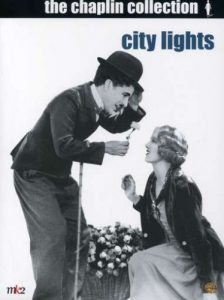In City Lights, Charlie Chaplin plays the part of Charlie the little tramp, a homeless vagabond, who encounters a flower girl, only to discover that she’s blind. After Charlie rescues an inebriated rich man from committing suicide, the eccentric millionaire decides that Charlie is his best friend, and takes him out partying, gives him a car, etc. — only to totally forgot about him when he’s sober.
City Lights (1931) starring Charlie Chaplin, Virginia Cherrill
Charlie uses the millionaire’s money (when he can) to help the blind girl. She mistakenly thinks that Charlie is the millionaire — but when the forgetful millionaire leaves town, Charlie needs to raise money to help the girl. Charlie works as a street sweeper, and tries to win a boxing match. The millionaire returns, inebriated, at the last moment, and cheerfully gives Charlie the money …. Only to forget about it moments later. The end of the movie is sad. It ends with a true tearjerker moment as Charlie and the flower girl, now cured of her blindness, are reunited.
Review of Charlie Chaplin’s City Lights
Today, I had a rare privilege — I was able to watch City Lights for the first time. Now, I’ve known of the movie for many years, known the general plot line, and had seen individual scenes, such as the hilarious boxing ring scene, but I’d never actually seen the entire movie. Now I have, and I have to say that it exceeded my expectations.
Charlie Chaplin is as his creative prime, wrapping slapstick and pathos together seamlessly. The movie begins, for example, with the dignitaries at an unnamed large city unveiling a new set of statues dedicated to “Peace and Prosperity” …. Only to have the sleeping Tramp lying on the lap of a statue be revealed. His getting down from the statue is truly hilarious, and sets the stage for the rest of the movie. The slapstick is hilarious, funny, and frenetic. And the characterizations are spot-on, with the romance slowly building between the shy Tramp and the blind flower girl. I’m not ashamed to say that I teared up at the very ending, after the Tramp has paid a high price for the surgery to pay for the flower girl’s sight-restoring surgery. And she only recognizes her benefactor after touching his hand. The ending is absolutely perfect.
I strongly recommend Charlie Chaplin’s City Lights, and I rate it a (very rare) 5 stars.
Product description of City Lights
Talkies were well entrenched when Charles Chaplin swam against the filmmaking tide with this forever classic that’s silent except for music and sound effects. The story, involving the Tramp’s attempts to get money for an operation that will restore sight to a blind flower girl, provides the star with an ideal framework for sentiment and laughs. The Tramp is variously a street sweeper, a boxer, a rich poseur, and a rescuer of a suicidal millionaire. His message is unspoken, but universally understood: love is blind
Trivia for Charlie Chaplin’s City Lights
- Orson Welles said that this was his favorite movie of all time.
- Charles Chaplin re-shot the scene in which the Little Tramp buys a flower from the blind flower-girl 342 times. He could not find a satisfactory way of showing that the blind flower-girl thought that the mute tramp was wealthy.
- In terms of years, this film was Charlie Chaplin’s longest undertaking. It was in production from 31 December 1927 – 22 January 1931, over three years. It shot for only 180 days, though.
- When the film opened on 31 January 1931, Albert Einstein joined Charlie Chaplin at the theater. When the film opened in England, George Bernard Shaw joined him.
- At one point, Virginia Cherrill came back to the set late from an appointment, keeping Charles Chaplin waiting. Chaplin, whose relationship with Cherrill was not friendly, fired her on the spot. He intended to reshoot the film with Georgia Hale, his heroine from The Gold Rush (1925), playing the flower girl. He even re-shot the final scene between the tramp and the flower girl with Hale in the role. However, Chaplin had already spent far too much time and money on the project to start over. Knowing this, Cherrill offered to come back to work – at double her original salary. Chaplin reluctantly agreed and the film was completed. (Source: Virginia Cherrill interview, Unknown Chaplin (1983)
- Winston Churchill visited the set, and Charlie Chaplin took a break to make a short film with him.
- Virginia Cherrill said that when she renegotiated her contract to be brought back onto the film, Marion Davies advised her.
Movie quotes for Charlie Chaplin’s City Lights
The Tramp (Charlie Chaplin): Tomorrow the birds will sing.
The Tramp (Charlie Chaplin): Be careful how you’re driving.
Eccentric Millionaire: Am I driving?
The Tramp (Charlie Chaplin): Can you see now?
A Blind Girl: Yes, I can see now.
Cast of characters
- Virginia Cherrill (Charlie Chan’s Greatest Case) … A Blind Girl
- Florence Lee … The Blind Girl’s Grandmother
- Harry Myers (Flat Foot Stooges) … An Eccentric Millionaire
- Al Ernest Garcia (The Circus) … The Millionaire’s Butler (as Allan Garcia)
- Hank Mann (Modern Times) … A Prizefighter
- Charlie Chaplin (The Kid (1921)) … A Tramp



